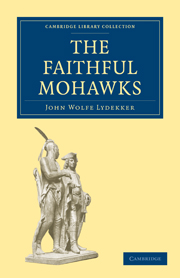Book contents
- Frontmatter
- Contents
- ILLUSTRATIONS
- FOREWORD BY THE RIGHT HONOURABLE LORD TWEEDSMUIR, G.C.M.G., C.H.
- PREFACE
- ABBREVIATIONS
- INTRODUCTION
- Chapter I PRELUDE (1664–1704)
- Chapter II THE FIRST DECADE (1704–1713)
- Chapter III THE NEXT THIRTY-THREE YEARS (1714–1746)
- Chapter IV THE CONFLICT FOR CANADA (i) (1747–1755)
- CHAPTER V THE CONFLICT FOR CANADA (ii) (1756–1760)
- CHAPTER VI THE YEARS BETWEEN (1761–1774)
- CHAPTER VII THE REVOLUTIONARY WAR (1775–1782)
- CHAPTER VIII “THE FAITHFUL MOHAWKS” (1783–1807)
- Appendix
- BIBLIOGRAPHY
- INDEX
- Plate section
CHAPTER VII - THE REVOLUTIONARY WAR (1775–1782)
Published online by Cambridge University Press: 07 September 2010
- Frontmatter
- Contents
- ILLUSTRATIONS
- FOREWORD BY THE RIGHT HONOURABLE LORD TWEEDSMUIR, G.C.M.G., C.H.
- PREFACE
- ABBREVIATIONS
- INTRODUCTION
- Chapter I PRELUDE (1664–1704)
- Chapter II THE FIRST DECADE (1704–1713)
- Chapter III THE NEXT THIRTY-THREE YEARS (1714–1746)
- Chapter IV THE CONFLICT FOR CANADA (i) (1747–1755)
- CHAPTER V THE CONFLICT FOR CANADA (ii) (1756–1760)
- CHAPTER VI THE YEARS BETWEEN (1761–1774)
- CHAPTER VII THE REVOLUTIONARY WAR (1775–1782)
- CHAPTER VIII “THE FAITHFUL MOHAWKS” (1783–1807)
- Appendix
- BIBLIOGRAPHY
- INDEX
- Plate section
Summary
On 19 April 1775 the shots fired at Lexington “which echoed round the world” were the prelude to eight years of fratricidal warfare unparalleled before or since in the annals of America. At the beginning of the conflict the balance of opinion lay fairly evenly divided. Actually the first Continental Congress of the previous year contained only a minority of avowed republicans, and many thousands of colonists, who later chose the cause of the “Patriots”, were as yet unprepared to throw off British rule. To the republican leaders one important aspect of the situation was early apparent, namely the attitude which the Six Nations of the Iroquois would adopt in the coming struggle. In the past the influence of the Iroquois Confederation had exercised a profound effect on the struggle for dominion between French Canada and the Thirteen English Colonies, and the “Patriots” at once realized the necessity of neutralizing the powerful forces which could thus be marshalled against them. Early in April, some two weeks before the battle of Lexington, the Provincial Congress of Massachusetts wrote to the Rev. Samuel Kirkland (the Dissenting missionary to the Oneidas) desiring him to act as their intermediary by delivering an address to the Mohawk sachems. At the same time the Congress sent a further message to the Stockbridge or “ River” Indians who maintained a close intimacy with the Oneidas.
- Type
- Chapter
- Information
- The Faithful Mohawks , pp. 139 - 168Publisher: Cambridge University PressPrint publication year: 2010First published in: 1938



